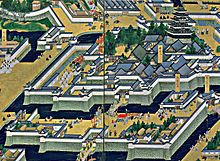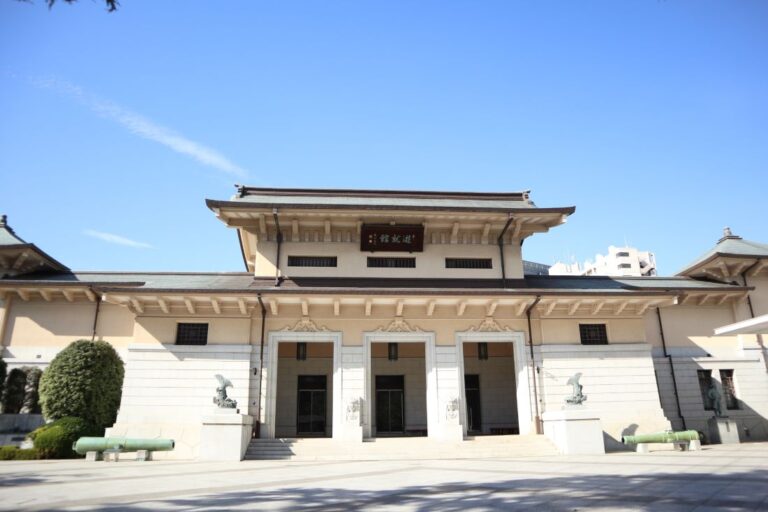Edo Castle, also known as Chiyoda Castle, is a historical landmark located in the heart of Tokyo, Japan. It was originally built in 1457 by Ōta Dōkan and served as the center of power for the Tokugawa shogunate for over 260 years. Today, it is part of the Tokyo Imperial Palace and serves as the residence of the Japanese emperor.

The castle was once a sprawling complex that included multiple buildings, gates, and walls, but much of it was destroyed over the centuries due to fires, earthquakes, and war. Despite this, several structures and features of the castle still remain, including the impressive stone walls, moats, and watchtowers. Visitors can explore the grounds and learn about the history of the castle and its significance in Japanese culture and politics.
History

Edo Castle was built in 1457 by Ōta Dōkan, a retainer of the Uesugi clan. It was originally called Musashi-no-kuni Edo-jō, meaning Edo Castle in Musashi Province. The castle was rebuilt several times over the years, with the most significant reconstruction taking place in the early 17th century under the rule of Tokugawa Ieyasu.
Under the Tokugawa shogunate, Edo Castle became the center of Japanese politics and culture. It served as the seat of government for more than 260 years, until the Meiji Restoration of 1868. After the restoration, Edo became the capital of Japan and was renamed Tokyo, and Edo Castle became the residence of the imperial family and was renamed the Imperial Palace.
During its long history, Edo Castle was the site of many important events. In 1701, the Forty-seven Ronin, a group of samurai who sought revenge for their master’s death, attacked the castle. The incident became one of the most famous stories in Japanese history and has been the subject of many books, plays, and movies.
Today, the Imperial Palace is still located on the site of the former Edo Castle, and visitors can tour the palace grounds and gardens. The palace is open to the public on January 2nd (New Year’s Greeting) and December 23rd (Emperor’s Birthday), as well as on special occasions such as the Emperor’s enthronement ceremony.
Architecture

Edo Castle is a masterpiece of Japanese architecture that has stood the test of time for centuries. Built in 1457 by Ōta Dōkan, the castle has undergone several renovations and expansions over the years. The castle’s architecture is a blend of traditional Japanese design and Western influence, reflecting the changing times in Japan’s history.
The castle’s keep, known as the donjon, was the tallest structure in Edo during the Tokugawa period. The donjon was built in the traditional Japanese style, with a wooden frame and plaster walls. The roof was covered in black tiles, giving the castle a distinctive appearance. The donjon had several floors, each with its own purpose. The top floor was used for observation, while the lower floors were used for storage and living quarters.
The castle’s walls were made of stone and were several meters thick. The walls were designed to withstand attacks from enemy forces and were built to last. The castle’s gates were also built to be strong and secure, with intricate designs that were both functional and aesthetically pleasing.
During the Edo period, the castle underwent several renovations and expansions to accommodate the growing needs of the Tokugawa shogunate. The castle’s gardens were also expanded and improved over the years, with new features added to enhance their beauty. Today, the castle’s gardens are open to the public and are a popular tourist attraction.
Layout

Edo Castle was built on a flatland and its initial layout was based on the principles of geomancy, also known as feng shui. This required a river to the east, a lake or ocean to the south, a road on the west, and a mountain to the north. The location chosen for the castle roughly met these requirements, and work began on its construction in 1457 by Ōta Dōkan.
The castle was built in the traditional Japanese style, with several concentric rings of fortifications and moats. The innermost ring was the Honmaru, which housed the main keep, audience chambers, and other important buildings. The Ninomaru was the second ring, which served as the living quarters for the shogun and his family. The Sannomaru was the third ring, which housed the offices of the shogun’s administration. The outermost ring was the Nishinomaru, which was used as a garden and a place for leisure activities.
The castle was also designed to be easily defended. The walls were made of stone and were several meters thick, with strategically placed gates and towers. The moats were filled with water from the nearby Sumida River, and were several meters deep.
Over the centuries, the castle underwent several renovations and expansions. In the 17th century, the shogun Tokugawa Ieyasu ordered the construction of several new buildings and gardens, including the famous Ninomaru Garden. In the 19th century, the castle was destroyed by fire and rebuilt several times. Today, only a few buildings and walls remain, but they are still an important part of Tokyo’s history and culture.
Significance

Edo Castle played a significant role in Japan’s history as the seat of power for the Tokugawa shogunate for over 260 years. It was the center of politics, culture, and military power during the Edo period, and its influence extended beyond Japan’s borders.
It was also a symbol of Japan’s isolationist policy during this period, as it was closed off to foreigners. The castle’s architecture and design were also significant and was built to withstand attacks from enemies, and its walls were made of stone and surrounded by moats.
The castle was also designed to be functional, with different sections serving different purposes, such as the main keep for the shogun’s residence and the inner and outer citadels for defense.
After the Meiji Restoration in 1868, Edo Castle was renamed the Imperial Palace and became the residence of the emperor. It’s significance shifted from military power to a symbol of Japan’s modernization and Westernization.
The castle was rebuilt in a European-style and became a symbol of Japan’s new era. Today, the Imperial Palace is still the residence of the emperor and his family, and the castle grounds are open to the public. Visitors can see the remnants of the castle’s original design, such as the stone walls and moats, as well as the modern architecture of the palace buildings.
The castle’s significance continues to be felt in Japan’s culture and history, as it remains a symbol of the country’s past and present.
Decline and Destruction

After nearly 250 years of being the center of power and politics in Japan, Edo Castle saw its decline and eventual destruction in the late 1800s. In 1868, the Meiji Emperor took over the castle and made it the center of the new government. However, the castle was no longer fit for purpose and was in need of extensive renovations.
In 1873, a fire broke out in the castle, destroying much of the inner palace and other important buildings. The government decided to demolish the remaining structures and rebuild the castle in a more modern style. The new castle, called the Imperial Palace, was completed in 1888 and remains the official residence of the Emperor of Japan today.
Despite the destruction of the physical structure of Edo Castle, its legacy lives on in the history and culture of Japan. The castle was a symbol of the power and influence of the Tokugawa shogunate, and its destruction marked the end of an era in Japanese history. Today, the site of Edo Castle is a popular tourist attraction, with visitors able to see the remaining stone walls and gates that once protected the castle.
Preservation and Restoration

Edo Castle has undergone several preservation and restoration efforts over the years to ensure that it remains a symbol of Japan’s rich history and culture. One such effort was the restoration of the castle’s main tower, which was completed in 2015. The tower, which was destroyed in a fire in 1657, was rebuilt using traditional methods and materials to preserve its historical significance.
In addition to the main tower, other parts of the castle have been restored, including the Ninomaru Palace and the Sannomaru Shozokan Museum. These restoration efforts have been carried out by skilled craftsmen who have used traditional techniques to ensure that the buildings remain true to their original design.

Preservation efforts have also been focused on the castle’s surrounding gardens, which were designed to complement the castle’s architecture. The gardens feature a variety of trees, plants, and flowers that are native to Japan, and have been meticulously maintained to ensure that they remain true to their original design.
One of the challenges of preserving Edo Castle is the fact that it was built using wood, which is susceptible to damage from fire and other natural disasters. To address this issue, the castle’s wooden structures have been treated with fire retardant chemicals to reduce the risk of fire damage.
Overall, the preservation and restoration efforts at Edo Castle have been successful in ensuring that the castle remains a symbol of Japan’s rich cultural heritage. Visitors to the castle can appreciate the beauty and history of this iconic landmark, and learn about the fascinating history of Japan’s feudal era.






